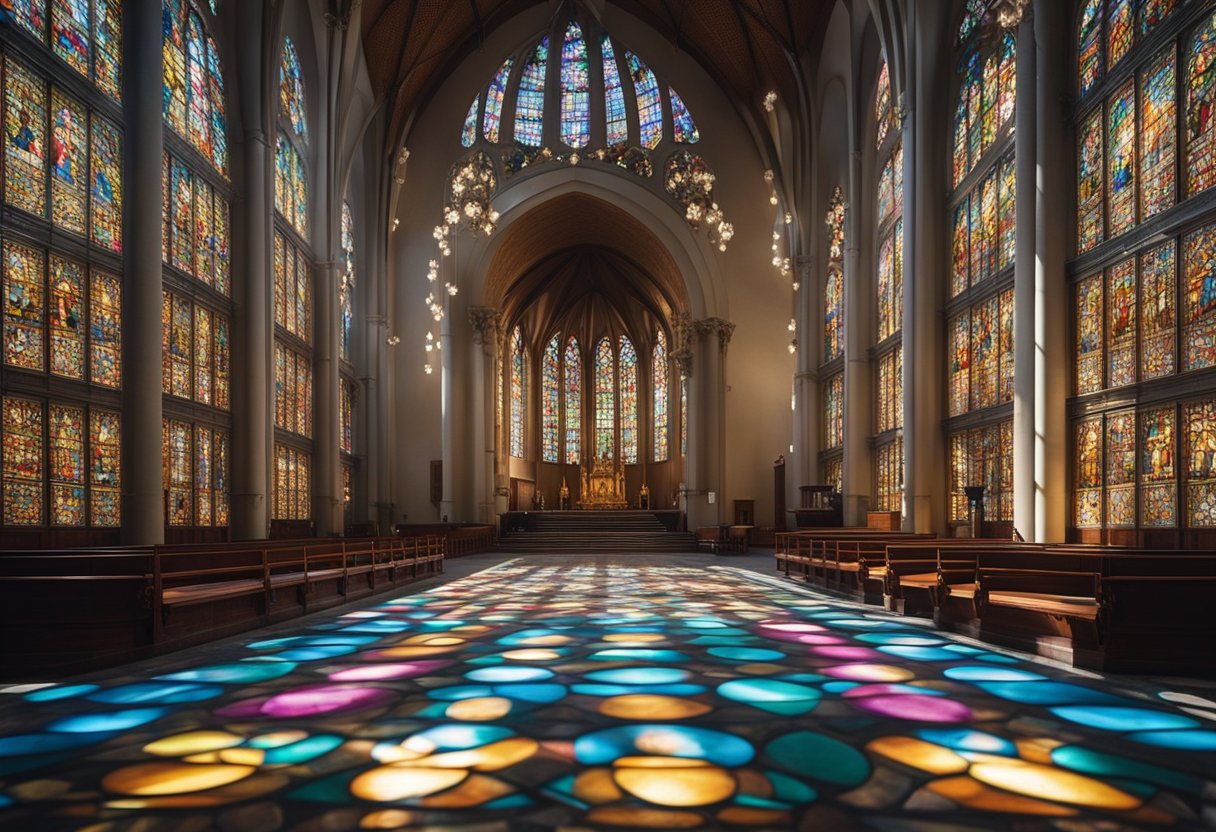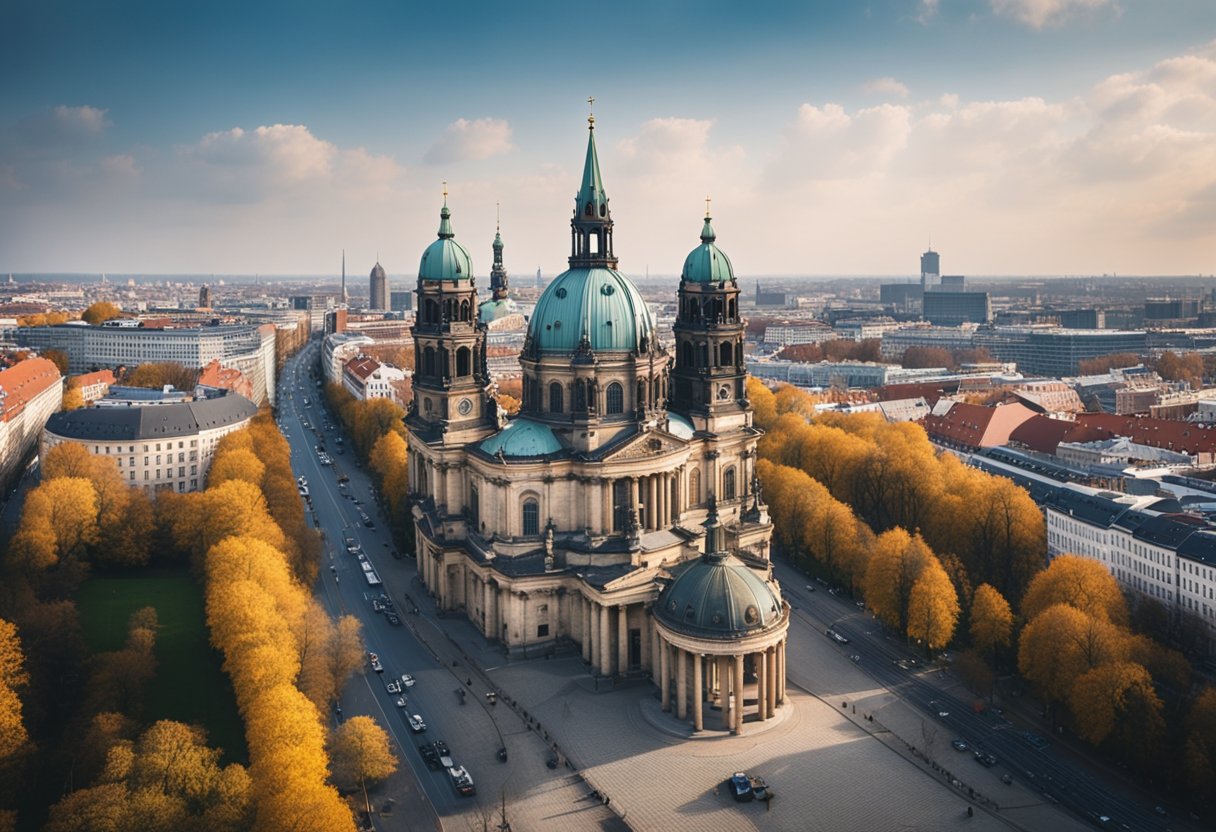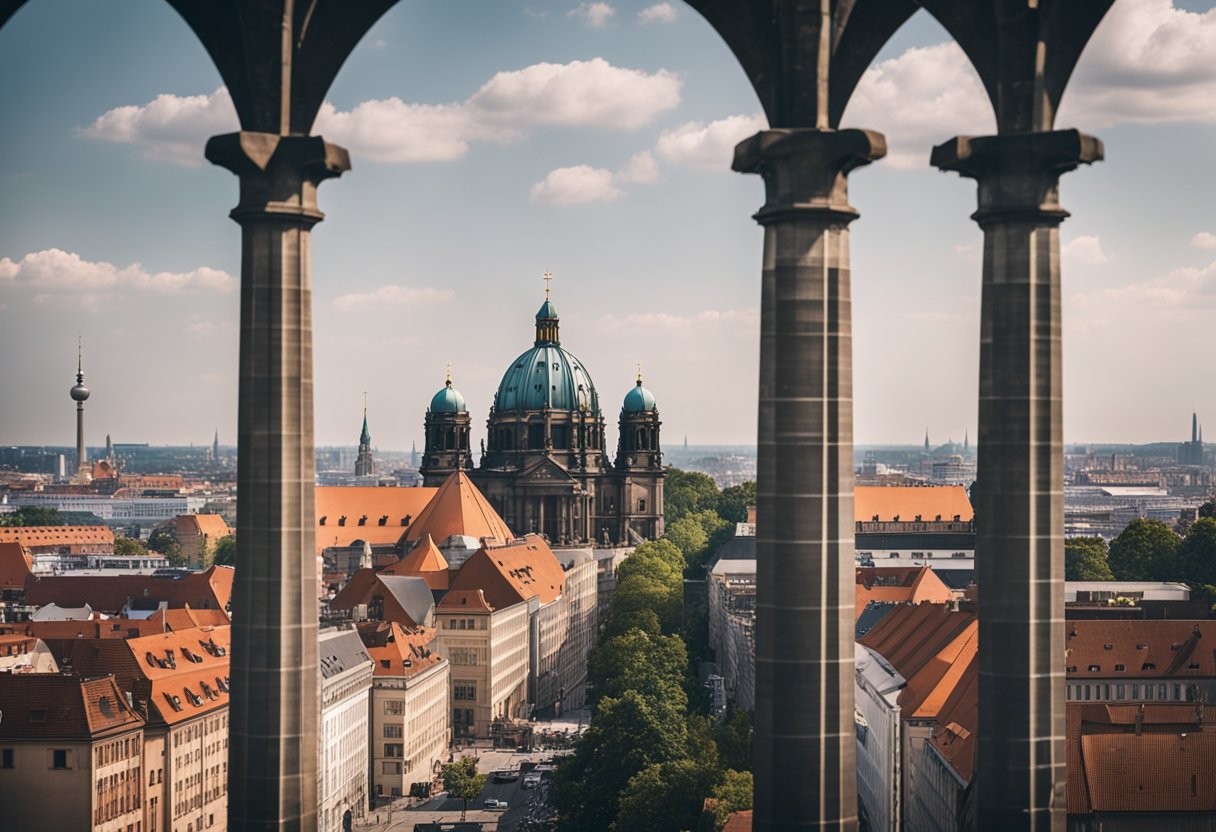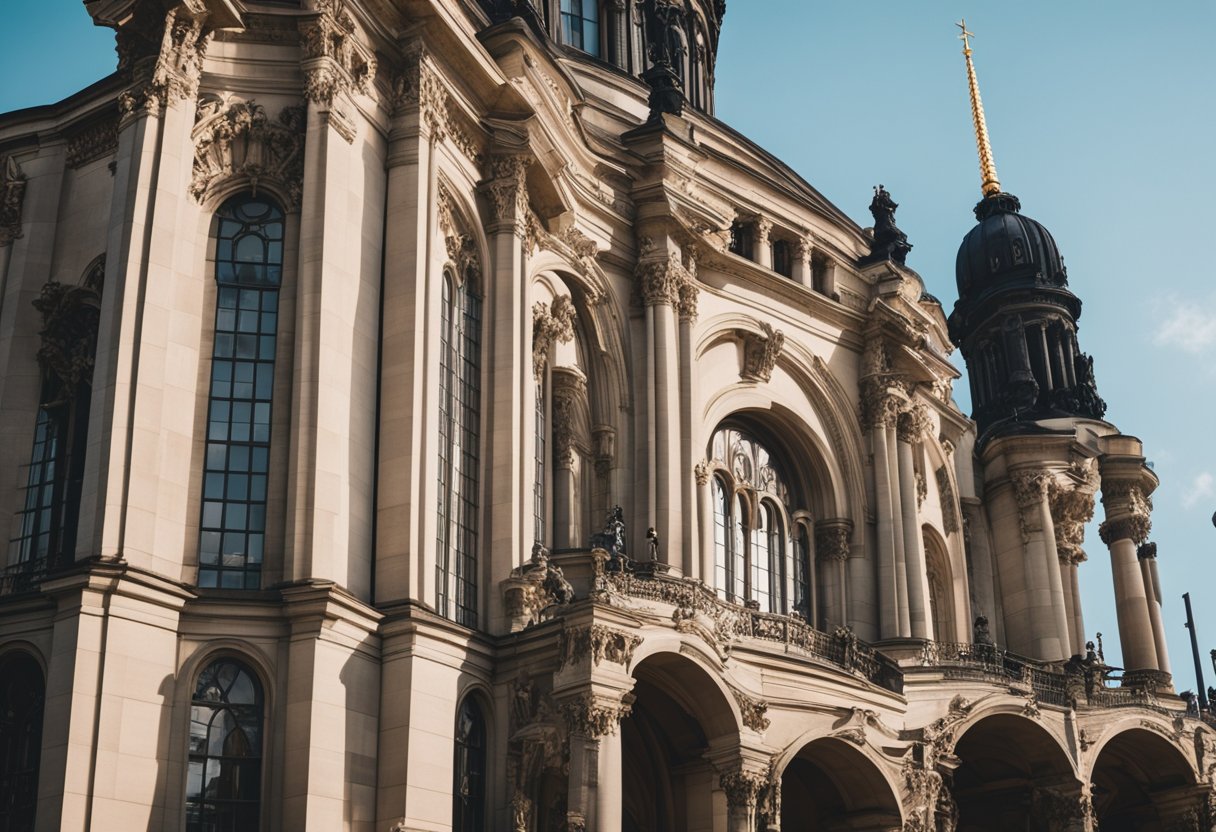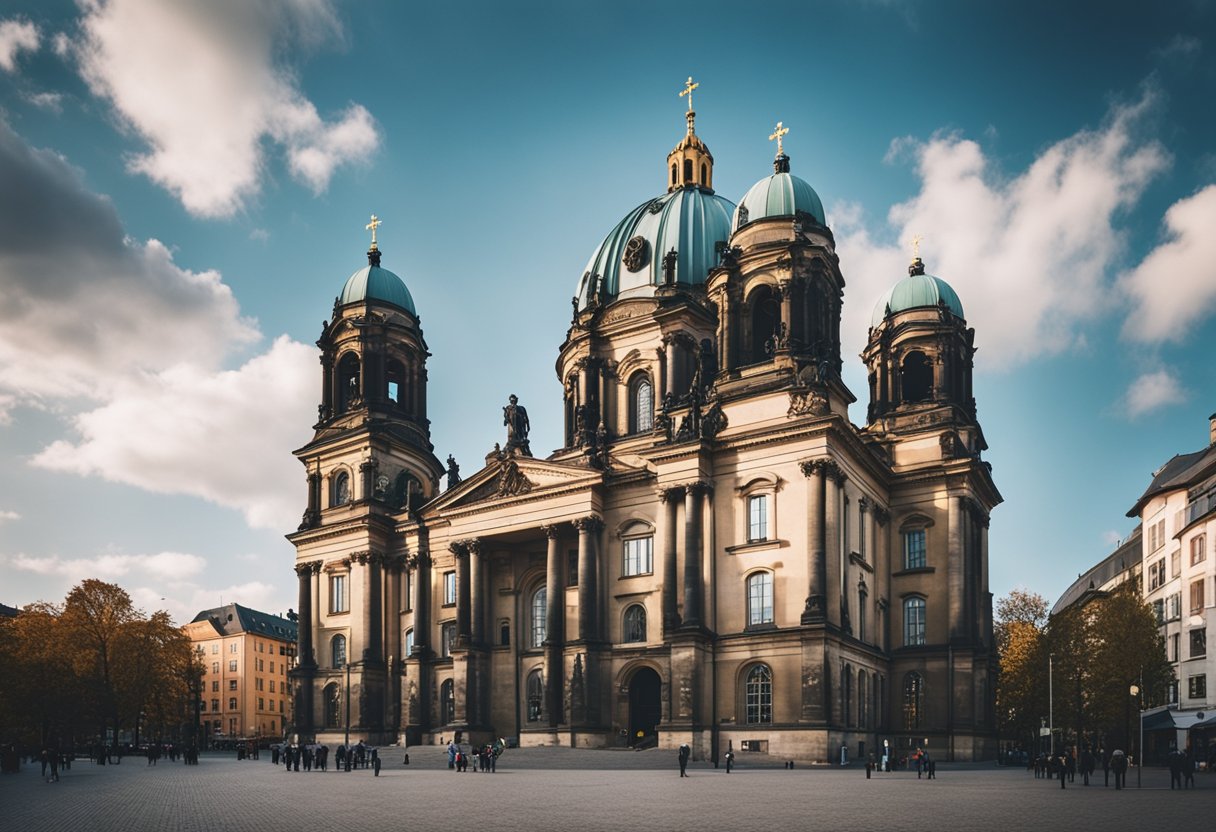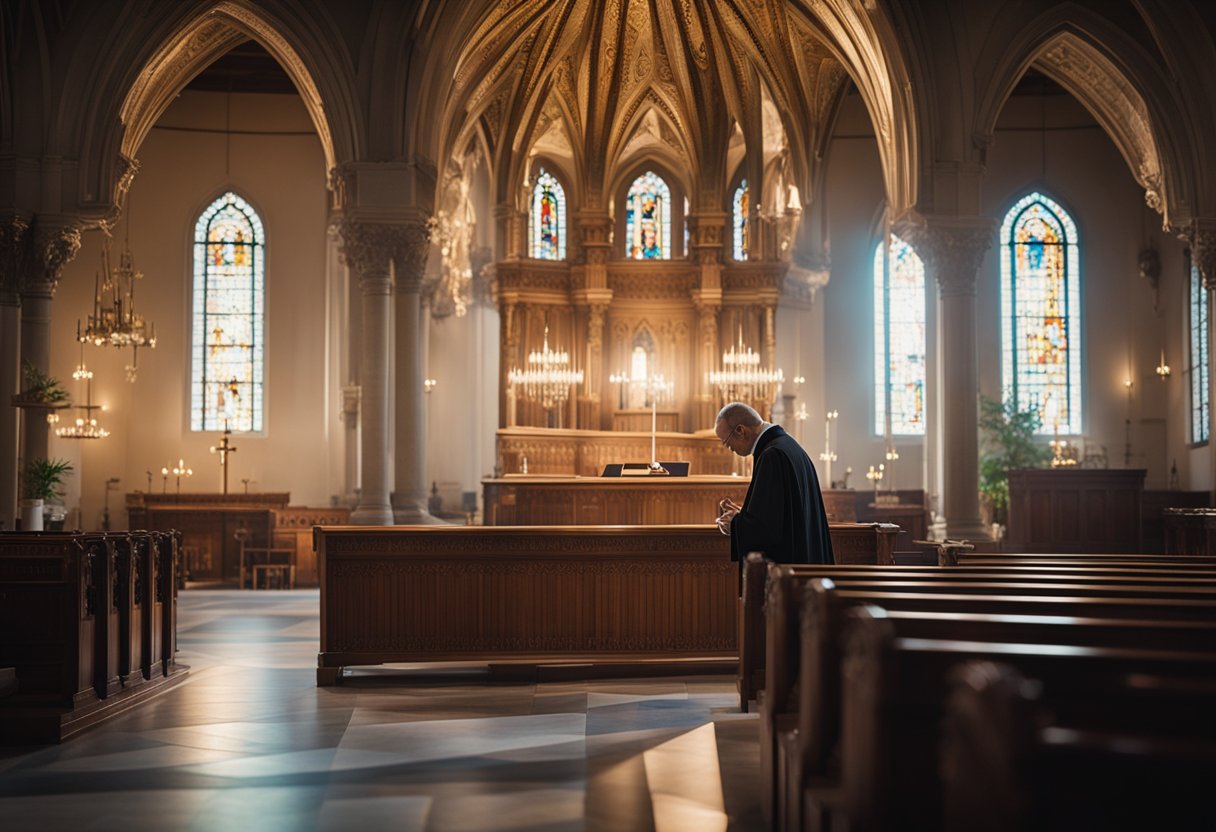Berlin, Germany, with its rich and turbulent history, houses a variety of Catholic churches that serve as both spiritual homes for the local Catholic community and landmarks of architectural and historical significance.
These Catholic Churches in Berlin are not only places of worship and religious gatherings but also bear witness to the intricate tapestry of events that have shaped the city.
From iconic structures like St. Hedwig’s Cathedral, which stands as a testament to Catholicism amidst a diverse urban landscape, to smaller community parishes, the Catholic churches in Berlin encompass a wide array of spiritual and cultural expressions.
The Catholic community in Berlin is served by the Roman Catholic Archdiocese of Berlin, which extends over the northeastern part of Germany.
This ensures that Catholic residents and visitors alike can find solace and fellowship within the city. In these sacred spaces, individuals engage in various religious practices, from the celebration of the Eucharist to moments of quiet reflection and prayer.
Devotions such as Eucharistic Adoration and Stations of the Cross are observed regularly, fostering a vibrant religious life within the capital city.
Each Catholic church in Berlin carries its unique character and history. For instance, St. Hedwig’s Cathedral, the seat of the archbishop, serves as the epicenter of Catholicism in Berlin, symbolizing the endurance and adaptation of the faith through the city’s changing fortunes.
Amidst the bustling cityscape, these churches offer a sanctuary for the faithful and stand as a testament to the enduring presence of the Catholic Church in Berlin.
History of Catholic Churches in Berlin
The trajectory of Catholicism in Berlin is marked by periods of suppression, resilience, and revival. The Catholic Church faced numerous challenges, from the Reformation to the calamities of war, and yet continued to maintain a presence in the German capital.
From Reformation to World War II
After the Reformation, the influence of the Roman Catholic Church in Berlin and throughout Germany was notably diminished. Yet, Catholics maintained a presence in the city despite the Protestant majority.
The Roman Catholic Archdiocese of Berlin was not established until over 300 years later, in1821, following the issuance of the Papal Bull “De salute animarum”. This reorganization played a crucial role in the revival of Catholic structures in the region.
One significant Catholic edifice to arise during this period was St. Hedwig’s Cathedral, which holds the distinction of being the first Catholic church constructed in Berlin after the Reformation—a symbol of Catholic endurance and adaptation.
Initially completed in 1773, it served as the lone Catholic house of worship in Berlin until 1854 and became a foundation for the Catholic community to rebuild after centuries of suppression.
World War II introduced a tumultuous era, with many churches, including Catholic ones, suffering damage or destruction. However, St. Hedwig’s Cathedral endured the war, albeit with significant injuries that necessitated restoration.
Post-World War II Developments
The end of World War II heralded a new phase of challenges and reconstruction for the Catholic Church in Berlin. The city, divided into East and West by its occupation zones, saw St. Hedwig’s Cathedral falling under the control of the East German government. The Cathedral became a central place of refuge and hope during these times of division and hardship.
Catholic reconstruction efforts in the latter half of the 20th century aimed at restoring damaged churches and erecting new ones to serve the faithful in a city once again growing rapidly. Despite the ideological constraints of the East German state, the Catholic Church persevered in its mission, ensuring the continuation of Catholic life and worship in Berlin.
Major Catholic Churches in Berlin
Berlin is home to some of the most architecturally significant and historic Catholic churches in Berlin Germany, each with its own story and community.
St. Hedwig’s Cathedral
St. Hedwig’s Cathedral is not only a vital place of worship for Catholics in Berlin but also a historical monument. This baroque structure, located at Bebelplatz, has a rich history spanning over two centuries and serves as the seat of the Archbishop of Berlin. It was designed by Georg Wenzeslaus von Knobelsdorff and constructed from 1747 to 1887, dedicated to Hedwig of Silesia.
Church of St. Boniface
Another prominent edifice for the Catholic community is the Church of St. Boniface. Situated in the central borough of Mitte, this church provides spiritual services and holds cultural significance within the Catholic Church in Berlin. It is an example of Catholic heritage in the midst of a modern cityscape.
St. Ludwig Church
Lastly, St. Ludwig Church stands out with its architectural beauty and active congregation. Renowned for its stunning ceiling frescoes and vibrant community life, St. Ludwig Berlin is a cornerstone of Catholic worship and fellowship in Berlin, embodying the city’s religious diversity and commitment to preserving sacred art and architecture.
Archdiocese and Governance
The Archdiocese of Berlin plays a pivotal role in the spiritual and organizational structure of the Catholic Church in Germany’s capital, with the Archbishop of Berlin being a key figure in guiding the local Catholic community.
The Archdiocese of Berlin
Location and Territory: The Archdiocese of Berlin spans across the northeast region of Germany. It is centered in the cosmopolitan city of Berlin, where St. Hedwig’s Cathedral, the most vital Catholic sacred building in the city, serves as the seat of the Archbishop of Berlin.
History and Present: This ecclesiastical jurisdiction has been shaped by its dynamic history, and today, it continues to be a significant ecclesial body within the Catholic Church in Germany. It is a Latin Church ecclesiastical territory and part of the universal Roman Catholic Church.
Church Administration
Leadership: At the helm is the Archbishop of Berlin, responsible for overseeing spiritual guidance and ecclesiastical governance within the archdiocese.
Councils and Synods: Administration is also characterized by various councils and a commitment to involving laity in ecclesiastical decisions. The idea of a “synodal council” for shared governance between all members of the Church (laity, priests, deacons, and bishops) reflects a progressive approach toward democratic participation within the Church’s structure.
Outreach and Community: Ensuring the archdiocese remains a central part of the community’s spiritual life, the church administration operates various programs and services that support both the spiritual and material needs of its members.
Community and Multicultural Aspects
Catholic churches in Berlin, Germany, serve as dynamic centers for a heterogeneous mix of cultural backgrounds, with multiple congregations offering services in various languages.
This network of churches is not only a place of worship but also provides a broad array of community support mechanisms and fosters an environment where English speakers, in particular, can find a spiritual home away from home.
Multicultural Congregations
Berlin’s Catholic community thrives on its ability to bring together people of diverse heritages under one sacred roof.
Numerous churches across the city boast multicultural congregations where parishioners from different countries and cultures unite. They celebrate their shared faith while also acknowledging their cultural diversity, offering a sense of belonging to both natives and immigrants alike.
Community Services and Support
Catholic churches in Berlin extend beyond spiritual guidance, acting as pillars for local support and charitable services.
These community services range from food distribution and housing assistance to educational programs that cater to various needs. They embody the essence of community by providing support systems dedicated to helping individuals and families navigate challenging times.
English-Speaking Mission
The existence of an English-speaking Roman Catholic Mission highlights the church’s recognition of Berlin’s international residents. This mission provides a focal point for the English-speaking community, offering services and liturgies in English.
It ensures that language barriers do not hinder individuals from participating in worship and community activities, thereby strengthening the fabric of the multicultural community.
Religious Services and Ceremony
Catholic churches in Berlin, Germany, offer a variety of religious services and ceremonies, which are central to the community’s spiritual life. These include Mass and Liturgy, Sacraments and Prayer, and diverse Roles and Ministries supporting the faithful.
Mass and Liturgy
The Holy Mass is the central act of worship in Berlin’s Catholic community, often held daily and with additional services over the weekend. At places such as St. Hedwig’s Cathedral, the faithful gather to participate in the liturgy and receive the Eucharist, which is celebrated with reverence and solemnity.
Various roles, like lectors who read scripture, and choir members, who contribute to the liturgical music, enhance the spiritual experience.
Sacraments and Prayer
Sacraments form a core part of Catholic life, with churches in Berlin administering rites such as Baptism, Confirmation, and Holy Matrimony.
Among these, the Sacrament of Reconciliation offers a personal experience for prayer and penance. Many churches also hold regular prayer sessions and opportunities for Eucharistic Adoration to deepen one’s relationship with the Lord.
Roles and Ministries
Vital to the church’s function are various ministries comprised of laypeople serving in different capacities. Eucharistic ministers assist in distributing communion, servers aid the priest during mass, and hospitality providers, such as greeters, ensure a welcoming environment. The participation of the laity demonstrates a shared responsibility for the church’s mission and vibrant faith life.
Architecture and Artistic Heritage
Catholic Churches in Berlin are not just places of worship, but they are also repositories of rich architectural heritage and art. These structures depict an evolution of styles, from the classic to modernist trends, marking the city’s historical and cultural journey.
Gothic and Baroque Influences
St. Hedwig’s Cathedral stands as a prime example of the influential Baroque style, which dominated the architectural landscape of Catholic churches in Berlin. Commissioned by Frederick the Great, the cathedral was constructed based on designs by Georg Wenzeslaus von Knobelsdorff.
Its construction spanned from 1747 to 1887, and it became a central element of the Forum Fridericianum. The cathedral’s historical significance is compounded by its dedication to Hedwig of Silesia and its status as a pinnacle of Catholic architectural heritage within the city.
Modern Church Structures
In contrast to the historical weight of the Gothic and Baroque influences, modern church architecture in Berlin embraces newer styles and materials. The 19th and early 20th centuries saw a shift towards brick or stone in Gothic or Romanesque revival styles.
However, by the 1920s, Berlin witnessed a wave of architectural experimentation within church designs, incorporating Art Deco, Expressionist, and modernist elements. These contemporary structures reflect a break from tradition and a step towards innovative design, fostering new forms of aesthetic and spiritual experiences for the faithful.
Church Community Life
Catholic churches in Berlin foster vibrant community life through various social, cultural, and educational programs. These programs are often centered in community halls, featuring kitchens for events and ongoing religious life enrichment.
Social and Cultural Events
Community halls within
Berlin, Germany, with its rich and turbulent history, houses a variety of Catholic churches that serve as both spiritual homes for the local Catholic community and landmarks of architectural and historical significance.
These Catholic Churches in Berlin are not only places of worship and religious gatherings but also bear witness to the intricate tapestry of events that have shaped the city.
From iconic structures like St. Hedwig’s Cathedral, which stands as a testament to Catholicism amidst a diverse urban landscape, to smaller community parishes, the Catholic churches in Berlin encompass a wide array of spiritual and cultural expressions.
The Catholic community in Berlin is served by the Roman Catholic Archdiocese of Berlin, which extends over the northeastern part of Germany.
This ensures that Catholic residents and visitors alike can find solace and fellowship within the city. In these sacred spaces, individuals engage in various religious practices, from the celebration of the Eucharist to moments of quiet reflection and prayer.
Devotions such as Eucharistic Adoration and Stations of the Cross are observed regularly, fostering a vibrant religious life within the capital city.
Each Catholic church in Berlin carries its unique character and history. For instance, St. Hedwig’s Cathedral, the seat of the archbishop, serves as the epicenter of Catholicism in Berlin, symbolizing the endurance and adaptation of the faith through the city’s changing fortunes.
Amidst the bustling cityscape, these churches offer a sanctuary for the faithful and stand as a testament to the enduring presence of the Catholic Church in Berlin.
History of Catholic Churches in Berlin
The trajectory of Catholicism in Berlin is marked by periods of suppression, resilience, and revival. The Catholic Church faced numerous challenges, from the Reformation to the calamities of war, and yet continued to maintain a presence in the German capital.
From Reformation to World War II
After the Reformation, the influence of the Roman Catholic Church in Berlin and throughout Germany was notably diminished. Yet, Catholics maintained a presence in the city despite the Protestant majority.
The Roman Catholic Archdiocese of Berlin was not established until over 300 years later, in1821, following the issuance of the Papal Bull “De salute animarum”. This reorganization played a crucial role in the revival of Catholic structures in the region.
One significant Catholic edifice to arise during this period was St. Hedwig’s Cathedral, which holds the distinction of being the first Catholic church constructed in Berlin after the Reformation—a symbol of Catholic endurance and adaptation.
Initially completed in 1773, it served as the lone Catholic house of worship in Berlin until 1854 and became a foundation for the Catholic community to rebuild after centuries of suppression.
World War II introduced a tumultuous era, with many churches, including Catholic ones, suffering damage or destruction. However, St. Hedwig’s Cathedral endured the war, albeit with significant injuries that necessitated restoration.
Post-World War II Developments
The end of World War II heralded a new phase of challenges and reconstruction for the Catholic Church in Berlin. The city, divided into East and West by its occupation zones, saw St. Hedwig’s Cathedral falling under the control of the East German government. The Cathedral became a central place of refuge and hope during these times of division and hardship.
Catholic reconstruction efforts in the latter half of the 20th century aimed at restoring damaged churches and erecting new ones to serve the faithful in a city once again growing rapidly. Despite the ideological constraints of the East German state, the Catholic Church persevered in its mission, ensuring the continuation of Catholic life and worship in Berlin.
Major Catholic Churches in Berlin
Berlin is home to some of the most architecturally significant and historic Catholic churches in Berlin Germany, each with its own story and community.
St. Hedwig’s Cathedral
St. Hedwig’s Cathedral is not only a vital place of worship for Catholics in Berlin but also a historical monument. This baroque structure, located at Bebelplatz, has a rich history spanning over two centuries and serves as the seat of the Archbishop of Berlin. It was designed by Georg Wenzeslaus von Knobelsdorff and constructed from 1747 to 1887, dedicated to Hedwig of Silesia.
Church of St. Boniface
Another prominent edifice for the Catholic community is the Church of St. Boniface. Situated in the central borough of Mitte, this church provides spiritual services and holds cultural significance within the Catholic Church in Berlin. It is an example of Catholic heritage in the midst of a modern cityscape.
St. Ludwig Church
Lastly, St. Ludwig Church stands out with its architectural beauty and active congregation. Renowned for its stunning ceiling frescoes and vibrant community life, St. Ludwig Berlin is a cornerstone of Catholic worship and fellowship in Berlin, embodying the city’s religious diversity and commitment to preserving sacred art and architecture.
Archdiocese and Governance
The Archdiocese of Berlin plays a pivotal role in the spiritual and organizational structure of the Catholic Church in Germany’s capital, with the Archbishop of Berlin being a key figure in guiding the local Catholic community.
The Archdiocese of Berlin
Location and Territory: The Archdiocese of Berlin spans across the northeast region of Germany. It is centered in the cosmopolitan city of Berlin, where St. Hedwig’s Cathedral, the most vital Catholic sacred building in the city, serves as the seat of the Archbishop of Berlin.
History and Present: This ecclesiastical jurisdiction has been shaped by its dynamic history, and today, it continues to be a significant ecclesial body within the Catholic Church in Germany. It is a Latin Church ecclesiastical territory and part of the universal Roman Catholic Church.
Church Administration
Leadership: At the helm is the Archbishop of Berlin, responsible for overseeing spiritual guidance and ecclesiastical governance within the archdiocese.
Councils and Synods: Administration is also characterized by various councils and a commitment to involving laity in ecclesiastical decisions. The idea of a “synodal council” for shared governance between all members of the Church (laity, priests, deacons, and bishops) reflects a progressive approach toward democratic participation within the Church’s structure.
Outreach and Community: Ensuring the archdiocese remains a central part of the community’s spiritual life, the church administration operates various programs and services that support both the spiritual and material needs of its members.
Community and Multicultural Aspects
Catholic churches in Berlin, Germany, serve as dynamic centers for a heterogeneous mix of cultural backgrounds, with multiple congregations offering services in various languages.
This network of churches is not only a place of worship but also provides a broad array of community support mechanisms and fosters an environment where English speakers, in particular, can find a spiritual home away from home.
Multicultural Congregations
Berlin’s Catholic community thrives on its ability to bring together people of diverse heritages under one sacred roof.
Numerous churches across the city boast multicultural congregations where parishioners from different countries and cultures unite. They celebrate their shared faith while also acknowledging their cultural diversity, offering a sense of belonging to both natives and immigrants alike.
Community Services and Support
Catholic churches in Berlin extend beyond spiritual guidance, acting as pillars for local support and charitable services.
These community services range from food distribution and housing assistance to educational programs that cater to various needs. They embody the essence of community by providing support systems dedicated to helping individuals and families navigate challenging times.
English-Speaking Mission
The existence of an English-speaking Roman Catholic Mission highlights the church’s recognition of Berlin’s international residents. This mission provides a focal point for the English-speaking community, offering services and liturgies in English.
It ensures that language barriers do not hinder individuals from participating in worship and community activities, thereby strengthening the fabric of the multicultural community.
Religious Services and Ceremony
Catholic churches in Berlin, Germany, offer a variety of religious services and ceremonies, which are central to the community’s spiritual life. These include Mass and Liturgy, Sacraments and Prayer, and diverse Roles and Ministries supporting the faithful.
Mass and Liturgy
The Holy Mass is the central act of worship in Berlin’s Catholic community, often held daily and with additional services over the weekend. At places such as St. Hedwig’s Cathedral, the faithful gather to participate in the liturgy and receive the Eucharist, which is celebrated with reverence and solemnity.
Various roles, like lectors who read scripture, and choir members, who contribute to the liturgical music, enhance the spiritual experience.
Sacraments and Prayer
Sacraments form a core part of Catholic life, with churches in Berlin administering rites such as Baptism, Confirmation, and Holy Matrimony.
Among these, the Sacrament of Reconciliation offers a personal experience for prayer and penance. Many churches also hold regular prayer sessions and opportunities for Eucharistic Adoration to deepen one’s relationship with the Lord.
Roles and Ministries
Vital to the church’s function are various ministries comprised of laypeople serving in different capacities. Eucharistic ministers assist in distributing communion, servers aid the priest during mass, and hospitality providers, such as greeters, ensure a welcoming environment. The participation of the laity demonstrates a shared responsibility for the church’s mission and vibrant faith life.
Architecture and Artistic Heritage
Catholic Churches in Berlin are not just places of worship, but they are also repositories of rich architectural heritage and art. These structures depict an evolution of styles, from the classic to modernist trends, marking the city’s historical and cultural journey.
Gothic and Baroque Influences
St. Hedwig’s Cathedral stands as a prime example of the influential Baroque style, which dominated the architectural landscape of Catholic churches in Berlin. Commissioned by Frederick the Great, the cathedral was constructed based on designs by Georg Wenzeslaus von Knobelsdorff.
Its construction spanned from 1747 to 1887, and it became a central element of the Forum Fridericianum. The cathedral’s historical significance is compounded by its dedication to Hedwig of Silesia and its status as a pinnacle of Catholic architectural heritage within the city.
Modern Church Structures
In contrast to the historical weight of the Gothic and Baroque influences, modern church architecture in Berlin embraces newer styles and materials. The 19th and early 20th centuries saw a shift towards brick or stone in Gothic or Romanesque revival styles.
However, by the 1920s, Berlin witnessed a wave of architectural experimentation within church designs, incorporating Art Deco, Expressionist, and modernist elements. These contemporary structures reflect a break from tradition and a step towards innovative design, fostering new forms of aesthetic and spiritual experiences for the faithful.
Church Community Life
Catholic churches in Berlin foster vibrant community life through various social, cultural, and educational programs. These programs are often centered in community halls, featuring kitchens for events and ongoing religious life enrichment.
Social and Cultural Events
Community halls within Berlin’s Catholic churches serve as hubs for a multitude of social and cultural events. These venues are equipped with kitchens, which allow for gatherings such as coffee hours after Mass where parishioners can connect.
Events can range from small group gatherings to larger celebrations, each designed to foster a sense of togetherness and belonging within the church’s community.
- St. Bernard’s Church: Host to Ash Wednesday Masses and other liturgical events that bring the community together. For details, visit the English-speaking Roman Catholic Mission.
- All Saints Catholic Community: Known for its modern church and outdoor facilities that accommodate various social events, celebrating unity in diversity within the community. More information can be found on their official website.
Religious Education and Formation
In Berlin, religious education and formation are vital aspects of the Catholic Church’s mission. Programs tailored for all ages cater to the spiritual growth and understanding of their faith. Celebrants and instructors lead sessions on catechesis, bible studies, and sacramental preparation, ensuring a comprehensive religious education.
- Archdiocese of Berlin: Offers religious education services extending over Northeast Germany. They aim to educate individuals in the Catholic faith through various means. Learn more from Wikipedia’s overview.
- English-speaking Roman Catholic Mission: Provides English language services for religious formation, helping a multicultural congregation to pray and worship. Further information is available on their webpage.
Conservation and Patronage
Catholic churches in Berlin, Germany, embody a rich historical heritage and require sustained efforts for conservation. Both preservation and financial backing play crucial roles in the sustained longevity and upkeep of these ecclesiastic edifices.
Preservation of Historical Churches
Historical Catholic churches in Berlin, such as St. Hedwig’s Cathedral, undergo meticulous preservation to maintain their structural integrity and cultural significance.
Restoration projects focus on aspects like the Blessed Sacrament Chapel, ensuring they remain true to their original design while incorporating necessary modern safety features. Preservation efforts also involve regular maintenance to prevent the deterioration of architectural features and artworks that are critical to the churches’ historic and religious values.
Financial Contributions and Funding
The financial sustenance of Catholic churches in Berlin often comes from a combination of parish contributions, grants, and donations from the community.
Funding is crucial for ongoing renovations, such as those seen at major Catholic institutions, and for the operation of places of worship.
Special fundraising campaigns may be designated for specific projects, including the upkeep of chapels like the Blessed Sacrament Chapel, ensuring they remain operational and accessible to worshippers and visitors alike.
Frequently Asked Questions
In Berlin, a city enriched with history, Catholic churches offer services in multiple languages, including English, to accommodate the city’s international community.
Where can I find an English-speaking Catholic church in Berlin?
English-speaking Catholics in Berlin can attend All Saints Berlin, which offers services in English and serves as a welcoming community for expatriates and travelers.
What is the schedule for English Mass services at Catholic churches in Berlin?
To find the latest schedule for English Mass services, parishioners should visit the website of All Saints Berlin where they regularly update service times to reflect any changes.
Can you list the mass times for Berlin’s prominent Catholic churches?
While the mass times for each church vary, visitors can find information regarding mass times on the individual websites of the Catholic churches, such as that for the Roman Catholic Archdiocese of Berlin.
What are some of the most famous Catholic churches to visit in Berlin?
St. Hedwig’s Cathedral stands out as a notable Catholic site which serves as the seat of the Roman Catholic Archdiocese of Berlin. Tourists also often visit Kaiser Wilhelm Memorial Church, a historical symbol commemorated for its wartime experience.
Which Catholic church is located in Berlin Mitte?
The St. Hedwig’s Cathedral, situated in the Mitte district, is the mother church of the Roman Catholic Archdiocese of Berlin and is a significant religious site located within Berlin Mitte.
Among the historical churches in Berlin, which ones have experienced bombing during wartime?
Kaiser-Wilhelm Memorial Church is an important religious structure that retains its bombed state as a memorial to the devastation of war, and it is frequently visited by those interested in the turbulent history of Germany.
serve as hubs for a multitude of social and cultural events. These venues are equipped with kitchens, which allow for gatherings such as coffee hours after Mass where parishioners can connect.
Events can range from small group gatherings to larger celebrations, each designed to foster a sense of togetherness and belonging within the church’s community.
- St. Bernard’s Church: Host to Ash Wednesday Masses and other liturgical events that bring the community together. For details, visit the English-speaking Roman Catholic Mission.
- All Saints Catholic Community: Known for its modern church and outdoor facilities that accommodate various social events, celebrating unity in diversity within the community. More information can be found on their official website.
Religious Education and Formation
In Berlin, religious education and formation are vital aspects of the Catholic Church’s mission. Programs tailored for all ages cater to the spiritual growth and understanding of their faith. Celebrants and instructors lead sessions on catechesis, bible studies, and sacramental preparation, ensuring a comprehensive religious education.
- Archdiocese of Berlin: Offers religious education services extending over Northeast Germany. They aim to educate individuals in the Catholic faith through various means. Learn more from Wikipedia’s overview.
- English-speaking Roman Catholic Mission: Provides English language services for religious formation, helping a multicultural congregation to pray and worship. Further information is available on their webpage.
Conservation and Patronage
Catholic churches in Berlin, Germany, embody a rich historical heritage and require sustained efforts for conservation. Both preservation and financial backing play crucial roles in the sustained longevity and upkeep of these ecclesiastic edifices.
Preservation of Historical Churches
Historical Catholic churches in Berlin, such as St. Hedwig’s Cathedral, undergo meticulous preservation to maintain their structural integrity and cultural significance.
Restoration projects focus on aspects like the Blessed Sacrament Chapel, ensuring they remain true to their original design while incorporating necessary modern safety features. Preservation efforts also involve regular maintenance to prevent the deterioration of architectural features and artworks that are critical to the churches’ historic and religious values.
Financial Contributions and Funding
The financial sustenance of Catholic churches in Berlin often comes from a combination of parish contributions, grants, and donations from the community.
Funding is crucial for ongoing renovations, such as those seen at major Catholic institutions, and for the operation of places of worship.
Special fundraising campaigns may be designated for specific projects, including the upkeep of chapels like the Blessed Sacrament Chapel, ensuring they remain operational and accessible to worshippers and visitors alike.
Frequently Asked Questions
In Berlin, a city enriched with history, Catholic churches offer services in multiple languages, including English, to accommodate the city’s international community.
Where can I find an English-speaking Catholic church in Berlin?
English-speaking Catholics in Berlin can attend All Saints Berlin, which offers services in English and serves as a welcoming community for expatriates and travelers.
What is the schedule for English Mass services at Catholic churches in Berlin?
To find the latest schedule for English Mass services, parishioners should visit the website of All Saints Berlin where they regularly update service times to reflect any changes.
Can you list the mass times for Berlin’s prominent Catholic churches?
While the mass times for each church vary, visitors can find information regarding mass times on the individual websites of the Catholic churches, such as that for the Roman Catholic Archdiocese of Berlin.
What are some of the most famous Catholic churches to visit in Berlin?
St. Hedwig’s Cathedral stands out as a notable Catholic site which serves as the seat of the Roman Catholic Archdiocese of Berlin. Tourists also often visit Kaiser Wilhelm Memorial Church, a historical symbol commemorated for its wartime experience.
Which Catholic church is located in Berlin Mitte?
The St. Hedwig’s Cathedral, situated in the Mitte district, is the mother church of the Roman Catholic Archdiocese of Berlin and is a significant religious site located within Berlin Mitte.
Among the historical churches in Berlin, which ones have experienced bombing during wartime?
Kaiser-Wilhelm Memorial Church is an important religious structure that retains its bombed state as a memorial to the devastation of war, and it is frequently visited by those interested in the turbulent history of Germany.
